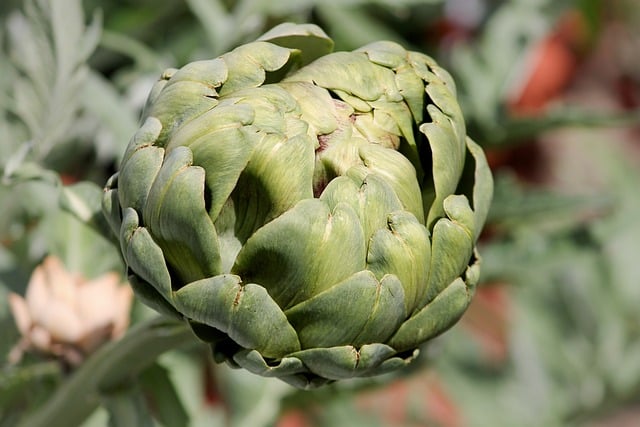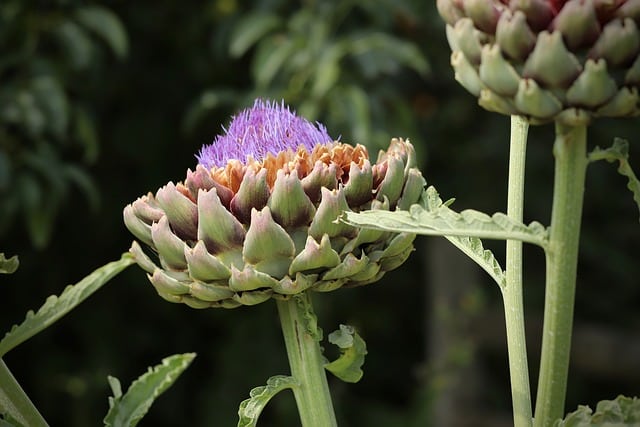Introduction – What To Know To Cultivate Your Own Artichokes
ShrinkThatFootprint advocates garden farms, in a sustainable way, to offset carbon emissions due to transportation. Today we’ll take a look at the thistle artichoke. Thistle is a plant that is found in many parts of the world. It has been used for centuries to make food and medicine and has interesting symbolic meanings in different cultures.

History Of The Artichoke For Human Consumption
The artichoke thistle is originally from the Mediterranean but can now be found in Asia and South America. Thistle has also been used as a source of food for livestock, and it is sometimes referred to as the “queen of pasture” because it provides much nutrition to grazing animals.
Artichokes are a form of cultivated cardoon that belongs to the thistle family. Artichokes were first grown by the Greeks over two thousand years ago and were introduced into other countries by Roman soldiers who brought them home as souvenirs from their conquests.
Today, artichokes are commercially grown in many countries around the world. They are much larger than other thistles but have the same prickly leaves and edible flower buds. Artichokes have a characteristic flavor that is described as nutty and earthy making it a popular choice for adding texture and complexity to various recipes. The thistles are prickly and have large, edible flower buds that can be cooked in many different ways. The most popular use of artichoke is to eat the flower bud before it grows into a large, thorny head.
Thistle Artichoke
The artichoke plant itself is also used as food for livestock since it is quite nutritious and easy for animals to digest. Even though it belongs to the thistle family, artichokes do not cause any negative reactions when consumed by humans. People around the world consider this vegetable to be quite delicious!
Artichoke thistle forms a rosette of very large leaves up to 2 feet in diameter. The leaves are heavily spined and have prickly edges, making them difficult to harvest by hand. The artichoke flower bud is the most popular part of this vegetable and can be consumed when it has reached a stage where it looks like a medium-sized head of lettuce.
The unopened bud has a firm texture but becomes soft and tender as it opens into an edible flower. They are typically eaten whole, including the fleshy base of the leaves, which contains many nutrients such as fiber, vitamins, and minerals.
Overall, the artichoke thistle is a fascinating plant that has played an important role in human history for centuries.
So You Want To Cultivate Artichoke
It is important to start with plants that have been specifically grown for this purpose to cultivate artichoke. You can purchase these plants from a garden center or online, and you should plant them in well-drained soil that receives plenty of sunlight. The plants should be spaced several feet apart, and you may need to stake them to help support the large leaves as they grow.
Mulch And Water Regularly
Provide regular watering and fertilizing during the growing season, especially when the flower buds are forming. You may need to apply mulch around the base of the plant to prevent weeds from sprouting and competing with your artichoke crop. Harvesting should occur when most buds have reached their full size but have not yet opened up.
Optimal Climate For Thistle Artichoke
Thistle artichoke prefers a warm climate with mild winters and warm summers. It can be grown in most regions of the United States, but will do best in areas with long, hot summers and mild winters. It is tolerant of drought, but will need some water during the growing season in order to produce larger, tastier artichokes.
The best time to plant thistle artichoke is in the spring, when the soil has warmed up and all danger of frost has passed. The thistle artichoke will require about 2-3 months to reach maturity, at which time it can be harvested and enjoyed!
Overall, cultivating artichoke is a relatively simple process that can be done successfully with some basic care and attention. With the right soil, site selection, and maintenance practices, you can enjoy a bountiful harvest of this delicious and nutritious vegetable.
Step-By-Step Process To Cultivate Thistle Artichoke
1. Purchase a packet of thistle artichoke seeds from a gardening store. This is the first step to grow thistle artichoke. You need to purchase a packet of thistle artichoke seeds from a gardening store in order to begin the process.
2. Select a sunny location in your garden to sow the seeds. Once you have the seeds, you need to select a sunny location in your garden where you can sow the seeds.
3. Prepare the soil by digging a hole approximately 10 inches deep. Before sowing the seeds, it is important to prepare the soil by digging a hole approximately 10 inches deep. This will help the seeds to germinate properly.
4. Place the seeds in the hole and cover with soil. Once the hole is ready, you need to place the seeds in the hole and cover them with soil. Plant the seeds directly in the ground, about an inch deep, and keep the soil moist but not soggy.
5. Water the soil well. After the seeds are planted, you need to water the soil well. This will help the seeds to germinate properly.
6. Keep the soil moist but not soggy. It is important to keep the soil moist but not soggy in order for the plants to grow properly.
7. Thin the thistle artichoke plants when they reach 4-6 inches in height. Once the thistle artichoke plants reach 4-6 inches in height, you need to thin them out. This will help the plants to grow properly and not overcrowd each other.
8. Harvest the thistle artichoke plants when they are fully grown, usually about 2-3 months after planting. After the plants have grown to their full size, usually about 2-3 months after planting, you can harvest them.
9. Enjoy the delicious edible thistle artichoke.
How Are Artichokes Used In Cooking?
Artichokes are a delicious and versatile ingredient in the kitchen. They can be steamed whole and eaten as-is, with a dip or vinaigrette for added flavor. Artichokes are commonly used in many different types of cooking, from simple preparations such as roasting or grilling to more complex dishes that involve braising and stuffing.

The leaves can also be plucked off and dipped, and you can scrape off the soft center portion at their base with the teeth. Others prefer to slice the artichoke in half, removing the fuzzy “choke” at its center before roasting or grilling it for a crispy texture on the outside and tender flesh within.
Some common ways to use artichokes in cooking include incorporating them into salads, pasta, or casseroles. They can also be sliced thinly and added to pizzas or flatbreads or chopped up and tossed into stir-fries. Artichokes are also often used in either raw or cooked dips and can be paired with other ingredients such as cheese, herbs, nuts, or vegetables.
Here are 3 dishes that feature artichokes.

- Carciofi alla Romana (Roman-Style Artichokes): This is a traditional dish from Rome, Italy, where artichokes are stuffed with garlic and herbs, then slow-cooked in olive oil and white wine. It’s a great representation of how Italians, especially those in Rome and the surrounding Lazio region, use artichokes in their cuisine.
- Artichoke Paella: A Spanish variation of the classic paella, where artichokes are a main ingredient along with rice and various other vegetables or meats. This dish is popular in Valencia and other parts of Spain where artichokes are grown.
- Artichoke Dip: A popular appetizer in the United States, this creamy dip usually contains artichokes, cheese, garlic, and mayonnaise. It’s often served hot with bread or chips.
How Do You Get Rid Of Thistle Artichokes?
A few different approaches can be used to get rid of thistle artichokes. One option is repeatedly cutting off the flower buds as they appear, which can help weaken and eventually kill the plant. Another strategy is to use herbicide sprays or injections, damaging the roots and preventing new growth.
Finally, you may consider using physical barriers such as thick plastic sheeting or heavy mulch, which can effectively block sunlight from reaching the artichoke plants. Ultimately, getting rid of thistle artichokes may require a combination of these methods to be effective.
Wrapping Up
Whether you enjoy a plate full of delicious artichokes or admire the beautiful flowers in your garden, it’s hard to deny the amazing qualities of thistle plants. Found on every continent except Antarctica, humans have used these remarkable plants for centuries as sources of food, medicine, and livestock feed. In addition to their culinary and medicinal uses, thistles are also valued for their ornamental qualities, with many types of thistles being popular choices in garden landscaping.
